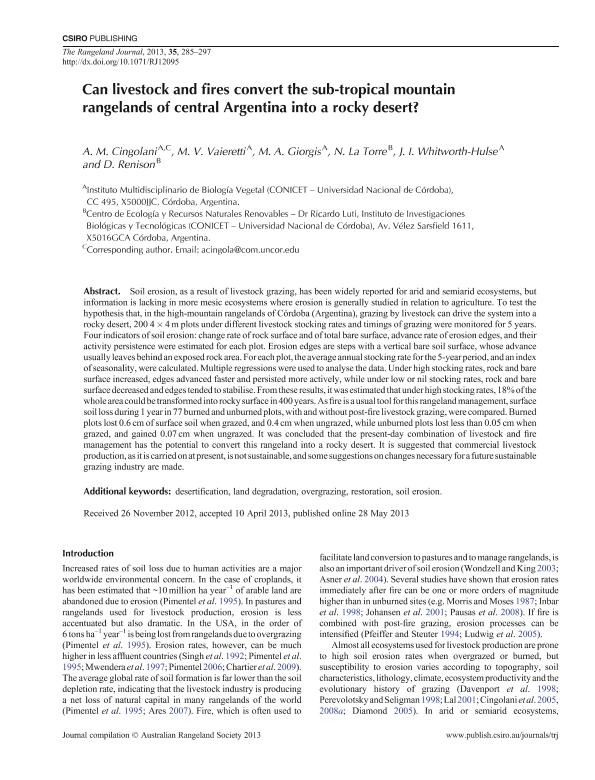Artículo
Can livestock and fires convert the sub-tropical mountain rangelands of central Argentina into a rocky desert?
Cingolani, Ana María ; Vaieretti, Maria Victoria
; Vaieretti, Maria Victoria ; Giorgis, Melisa Adriana
; Giorgis, Melisa Adriana ; La Torre, N.; Whitworth Hulse, Juan Ignacio
; La Torre, N.; Whitworth Hulse, Juan Ignacio ; Renison, Daniel
; Renison, Daniel
 ; Vaieretti, Maria Victoria
; Vaieretti, Maria Victoria ; Giorgis, Melisa Adriana
; Giorgis, Melisa Adriana ; La Torre, N.; Whitworth Hulse, Juan Ignacio
; La Torre, N.; Whitworth Hulse, Juan Ignacio ; Renison, Daniel
; Renison, Daniel
Fecha de publicación:
03/2013
Editorial:
Australian Rangeland Soc
Revista:
Rangeland Journal
ISSN:
1036-9872
Idioma:
Inglés
Tipo de recurso:
Artículo publicado
Clasificación temática:
Resumen
Soil erosion, as a result of livestock grazing, has been widely reported for arid and semi-arid ecosystems, but information is lacking in more mesic ecosystems where erosion is generally studied in relation to agriculture. To test the hypothesis that, in the high-mountain rangelands of Córdoba (Argentina), grazing by livestock can drive the system into a rocky desert, two-hundred 4 x 4 m plots under different livestock stocking rates and timings of grazing were monitored for five years. Four indicators of soil erosion: change rate of rock surface and of total bare surface, advance rate of erosion edges, and their activity persistence were estimated for each plot. Erosion edges are steps with a vertical bare soil surface, whose advance usually leaves behind an exposed rock area. For each plot, the average annual stocking rate for the five-year period, and an index of seasonality, were calculated. Multiple regressions were used to analyze the data. Under high stocking rates, rock and bare surface increased, edges advanced faster and persisted more actively, while under low or nil stocking rates, rock and bare surface decreased and edges tended to stabilize. From these results, it was estimated that under high stocking rates, 18 % of the whole area could be transformed into rocky surface in 400 years. As fire is a usual tool for this rangeland management, surface soil loss during one year in 77 burned and unburned plots, with and without post-fire livestock grazing, were compared. Burned plots lost 0.6 cm of surface soil when grazed, and 0.4 cm when ungrazed, while unburned plots lost less than 0.05 cm when grazed, and gained 0.07 cm when ungrazed. It was concluded that the present-day combination of livestock and fire management has the potential to convert this rangeland into a rocky desert. It is suggested that commercial livestock production, as it is carried-on at present, is not sustainable, and some suggestions on changes necessary for a future sustainable grazing industry are made.
Palabras clave:
Soil Erosion
,
Livestock
,
Desertification
,
Land Degradation
Archivos asociados
Licencia
Identificadores
Colecciones
Articulos(IMBIV)
Articulos de INST.MULTIDISCIPL.DE BIOLOGIA VEGETAL (P)
Articulos de INST.MULTIDISCIPL.DE BIOLOGIA VEGETAL (P)
Citación
Cingolani, Ana María; Vaieretti, Maria Victoria; Giorgis, Melisa Adriana; La Torre, N.; Whitworth Hulse, Juan Ignacio; et al.; Can livestock and fires convert the sub-tropical mountain rangelands of central Argentina into a rocky desert?; Australian Rangeland Soc; Rangeland Journal; 35; 3; 3-2013; 285-297
Compartir
Altmétricas



